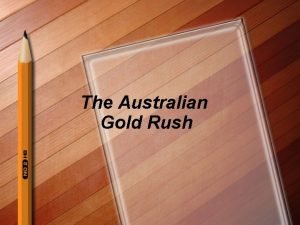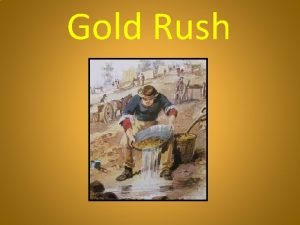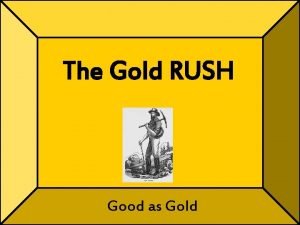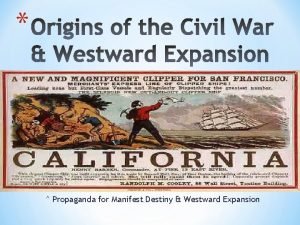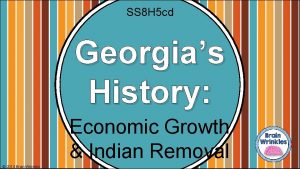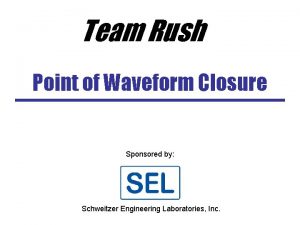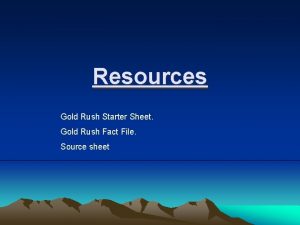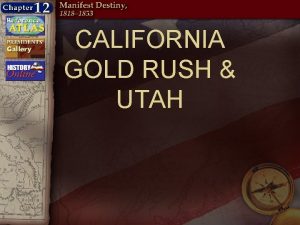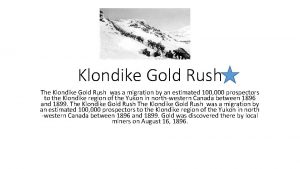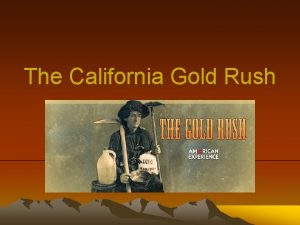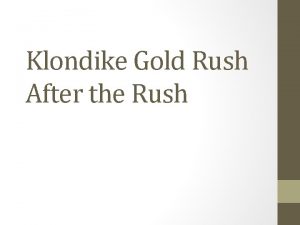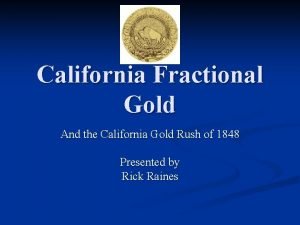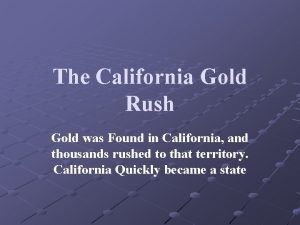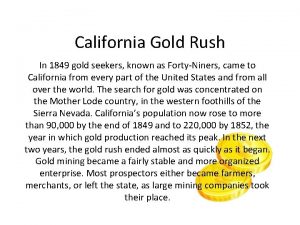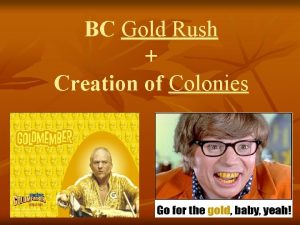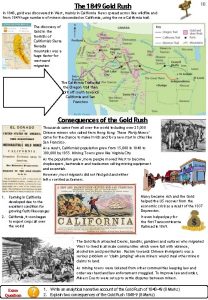Gold Rush Migration and Expansion The Road to


















- Slides: 18

Gold Rush, Migration and Expansion

The Road to the Civil War • • • Manifest Destiny The Texas Revolution The US-Mexico War, 1846 -8 Gold Rush, Migration and Expansion Compromise of 1850 Uncle Tom’s Cabin, 1852 Kansas-Nebraska Act, 1854 Bleeding Kansas, 1854 -6 Dredd Scott Decision, 1857 John Brown’s Raid on Harper’s Ferry 1860 Presidential Election

Go West, Young man!


• Complete Explanation: • A satire, puzzling in its precise meaning, on the ascendance of the radical wing of the Whig party in New York's gubernatorial election of 1846. • Influential radical journalist Horace Greeley dances a jig to the music of an ensemble of raccoon musicians. He is called "One of the "Young" Bo-hoys" because of his support of successful liberal Whig candidate John Young, who defeated Democratic incumbent governor Silas Wright. • The raccoons, symbolizing Henry Clay's supporters in the 1844 election, are optimistic about the outlook for the next presidential race. • • Greeley yells, "Where's Webbs 30, 000 men in Buckram now? " a Shakespeare reference. Violinist: "Play up Clays Grand March for 1848!" Horn player: "Don't commit yourself Brother Coon!" Drummer: "We are always committed to Harry of the West!" Cellist: "I go that-he is the only man for our side of the House!" Flutist: "10, 000 for Young! what a change in a year!" Trumpeter: "Wait until spring & you will see another great Victory brother!" • On the far right a coon holds up sheet music entitled "For [ex-governor Silas] Wright is a used up man. "

Territorial Expansion

Now What? • Manifest Destiny and War expanded the US to the Pacific Ocean • Westward Expansion of Slavery after US-Mexico War • Debates over slavery in the West ripped the country apart

Factors affecting westward expansion • Geographic and economic factors that influenced westward movement • Population growth in the eastern states • Availability of cheap, fertile land • Economic opportunity, e. g. , gold (California Gold Rush), logging, farming, freedom (for runaway slaves) • Cheaper and faster transportation, e. g. , rivers and canals (Erie Canal), steamboats • Knowledge of overland trails (Oregon and Santa Fe) • Belief in the right of “Manifest Destiny”—The idea that expansion was for the good of the country and was the right of the country

Important Inventions • The cotton gin was invented by Eli Whitney. It increased the production of cotton and thus increased the need for slave labor to cultivate and pick the cotton.

Important Inventions – Cotton Gin

Important Inventions • Jo Anderson (a slave) and Cyrus Mc. Cormick worked to invent the reaper. The reaper increased the productivity of the American farmer.

Important Inventions - Reaper

Famous Inventions • The steamboat was improved by Robert Fulton. It eventually provided faster river transportation that connected Southern plantations and farms to Northern industries and Western territories. • The steam locomotive provided faster land transportation.

Gold Rush-1849 - 1870 • Gold was discovered in California in 1849. • The Comstock Lode, a Bonanza, was later discovered. • People who moved west to mine are called miners. • Immigrants, such as Mexicans, Chinese and the Irish, went to work in the mines. • Immigrants were treated poorly with long hours, low pay and very dangerous work.

How does the Gold Rush fit in? • When a golden pebble was discovered at Johann Sutter’s sawmill in 1848, setting off the Gold Rush, many in the South believed that profitable new territory had become available for their peculiar institution. • Southerners and Free-Soilers spent the next decade in a fight over California in a story that is integral to the story of how the Civil War began.

How does the Gold Rush fit in? • It included the shooting of a senator, a scheme to split California in half, and a confrontation between miners and a group of Texans who tried to use slaves to stake their claims. • We even see Jefferson Davis, the future Confederate President, agitating (complaining, trying to get people to be vocal about a particular position) for a transcontinental rail route that would make California “an appendage of the South. ” • What would that have meant for America?

Background on the Gold Rush

Now What? • Manifest Destiny and War expanded the US to the Pacific Ocean • Westward Expansion of Slavery after US-Mexico War • Debates over slavery in the West ripped the country apart
 When did the gold rush start and end in australia
When did the gold rush start and end in australia Acrostic poem on food
Acrostic poem on food Math help room purdue
Math help room purdue The last gold rush belongs as much
The last gold rush belongs as much How did edward hargraves start the gold rush
How did edward hargraves start the gold rush The last gold rush belongs as much
The last gold rush belongs as much Implant gold rush
Implant gold rush Manifest destiny propaganda
Manifest destiny propaganda Dahlonega gold rush definition
Dahlonega gold rush definition Gold rush 250 000
Gold rush 250 000 What is paved and unpaved road
What is paved and unpaved road Gold road trade
Gold road trade Rush copley diabetes center
Rush copley diabetes center Jennifer rush
Jennifer rush Ship alarm signals
Ship alarm signals White rush bath salts
White rush bath salts Rush point controls
Rush point controls Rush ultrasound protocol
Rush ultrasound protocol Sonic rush review
Sonic rush review
